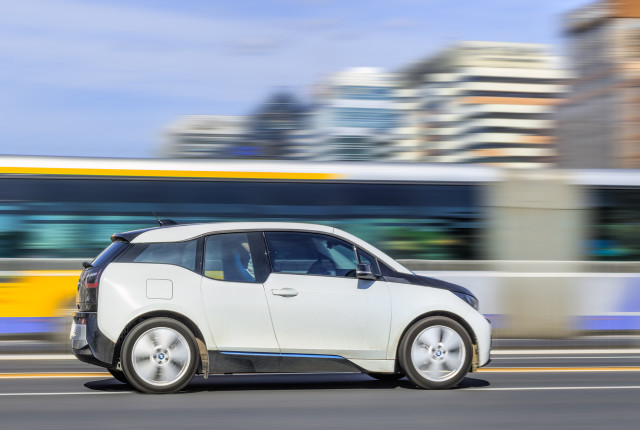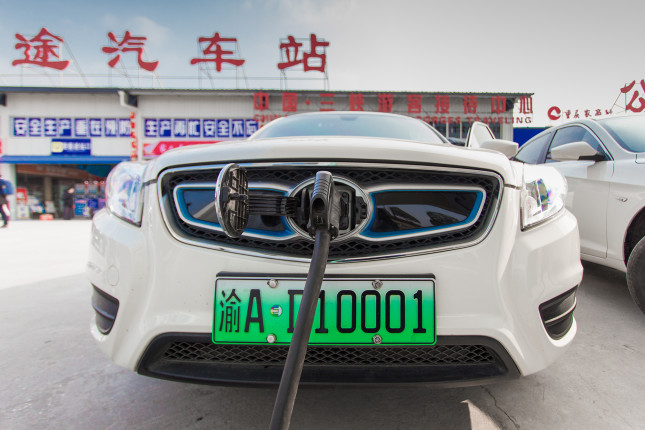-
Race to Carbon Neutrality: Electric Vehicles in China and the United States
May 20, 2021 By Ruyi LiThe year of the Ox came riding in on an electric vehicle (EV) with news that both the United States and Chinese governments were accelerating efforts to expand EV markets. In 2020, China sold 41 percent of the world’s EVs and now, the United States wants to be in the race too. On January 1 of this year, China’s Ministry of Finance slashed subsidies on electric, plug-in hybrids, and fuel cell automobiles by 20 percent, which is around 9 percent of the average retail price. By the end of 2022, it will halt subsidies in an EV Darwinism move as it did with solar PV panel companies to give a boost to the strongest players. Also in January, the Biden Administration announced a plan to electrify 645,000 federally procured vehicles.
Recent moves towards low-carbon transport could be a game changer for each country to reach their carbon neutrality goals. Transportation is the number one source of U.S. greenhouse gas emissions (29 percent), and the second-largest source (11 percent, according to iCET) in China. Notably, the April U.S.-China Joint Statement Addressing Climate Crisis highlighted green and low carbon transportation as one area of collaboration, or maybe a source of healthy competition, on the road to decarbonization.
Cities Accelerating EV Growth
With their traffic-packed streets, Beijing, Shanghai, Guangzhou, New York, Chicago, and Los Angeles are all in the global top ten for the largest carbon footprints. Besides CO2, personal automobiles and trucks are also the greatest source of particulate matter, like NOx, VOC, and sulfur dioxide pollution, in cities. Many U.S. and Chinese cities are offering incentives to consumers to drive EVs. In California, for example EV drivers can use high-occupancy vehicle lanes even when driving alone. In Portland, Oregon EV owners enjoy an extensive charging network, while Nashville, Phoenix, Raleigh, Salt Lake City, and many California cities have preferential parking policies for EV drivers.
Both countries also offer consumer subsidies. Since 2016, the U.S. government has been giving tax credits for EVs and plug-in hybrid car purchases, which will phase out when manufacturers sell 200,000 vehicles. According to Dr. Ilaria Mazzocco, senior research associate at the Paulson Institute, Chinese cities have been crucial in providing incentives to EV buyers. For example in 2014, Shenzhen buyers of BYD’s e6 model received a one-third discount, thanks to a $9,200 city subsidy on top of an $8,800 national subsidy.
In November 2020, Didi, the world’s largest shared car network, launched BYD D1, an electric vehicle built for ride-hailing in Chinese cities. In the United States, Uber has already pledged to shift to 100 percent electric vehicles by 2030. Despite the pandemic hindering the car-sharing industry, it has the potential to expand low-carbon transport in both countries.
Post-Subsidy China Seeks an On-Ramp for EV Markets
“When we talk about electric vehicles, two governments are truly the game changers—China and California,” said Dr. Camron Gorguinpour from Engie Impact in an interview. China has modeled its own new energy vehicle (NEV) credit trading program on California’s Zero-emission Vehicles (ZEV) Program established by the California Air Resources Board (CARB) more than a decade ago. CARB sets the annually increasing EV production targets—automobile manufacturers that fail to meet them must buy ZEV credits from other companies who have exceeded their production quota.
China’s NEV trading program has a dual-credit policy that forces automobile manufacturers to produce more cars that pollute less and are more fuel efficient. To rev up the NEV credit market, in September 2017, China’s Ministry of Industry and Information Technology (MIIT) finalized a mandatory EV production quota. It required carmakers whose annual sales exceed 30,000 to produce no less than 10 percent NEVs in their total car production in 2019. The quota will be increased to 18 percent by 2023.

Obstacles for China Along the Race Track
China’s NEV credit trading market aims to create profits for the overperformers and heavy costs on those lagging behind. However, this market is suffering from an oversupply of credit due to low credit prices. California’s ZEV Program has a credit price nine times higher than China’s. Tesla has earned more than 2 billion dollars by selling ZEV credits in the United States, but very little from the credit market in China.
Local governments still offer direct subsidies or procurement to boost the sales of their home-based EV producers, which has led to the overproduction of EVs. NIO, a Tesla competitor in China, was brought back from the verge of bankruptcy with a billion dollar government investment from its hometown, Hefei. The fragmented and over subsidized EV market undermines the NEV credit trading market.
Come on Baby Drive My Electric Bus and Plug into My Grid
Electrification of public transportation has been a growth area in both countries, with China very much in the lead. The Shenzhen-based BYD battery and EV company helped the city flip its whole bus and taxi fleets to electric in 2018. BYD has taken its operation to many other Chinese cities and onto the Belt and Road to electrify public transport in Chile, Brazil, and other Latin American countries.
U.S. cities are also moving faster in this space. In 2018, CARB pioneered the regulation that set a statewide goal for all public transit agencies to commit to 100 percent zero-emission bus fleets by 2040. Other U.S. cities are following suit under the “California Effect.” Virginia’s leading energy provider, Dominion Energy, released its electric school bus initiative in September 2020 to electrify the whole fleet by 2030. Electrifying fleet vehicles not only lowers air pollution and carbon emissions, but also contributes to a more stable power grid as these batteries can be used for balancing storage.
According to Gorguinpour, one area where the United States is leading the world in the EV space is a new technology called Vehicle-Grid Integration (VGI). VGI enables bidirectional energy exchange between EVs and the power grid. For example, when extreme weather caused power outages in 2021 in Texas, the state used VGI smart two-way charging technology to tap power stored in electric vehicles to help keep the lights on. Similarly, at peak electricity times, EVs can help add power to stabilize the electricity grids.
A Carbon Neutrality Drag Race?
To maintain its lead in the global EV drag race, the Chinese government will continue its carrot and stick approach to increase production. However, the real prize in EV leadership will be controlling the storage battery market.
In an interview, Dr. Feng An, executive director of the Innovation Center for Energy and Transportation (iCET), argued that China has done enough to ensure vehicle production, and the government is now prioritizing global leadership in EV infrastructure and supporting innovation in EV batteries, battery swapping, charging stations, and battery recycling. The California ZEV program and similar state programs highlight a model of technology-pushing policies that China could deploy more widely to develop a free market for EVs.
Camron Gorguinpour explained at a recent Wilson Center webinar that while the U.S. lags in deploying EVs, it leads in vehicle development, battery innovation, and technology-pushing policies. The Biden infrastructure proposal includes $174 billion for EVs that could accelerate the U.S. innovation and EV infrastructure. At the same meeting, Dr. Shelly Francis, Director of EV Noir, stressed that besides innovating on technology, such investment should also promote more equitable access to EV infrastructure in communities of color and rural areas.
Ruyi Li is a researcher at Wilson Center’s China Environment Forum. Her recent focuses are waste management in Asia and low carbon transition in China. She graduated from Johns Hopkins University (SAIS) with an MA in Energy, Resources & Environment and International Economics.
Sources: Barron’s, Bloomberg, BYD, California Air Resources Board, California Public Utilities Commission, Center for Climate and Energy Solutions, China Daily, DiDi Global, Columbia University Center on Global Energy Policy, EcoWatch, Edmunds, ENGIE Impact, Environmental and Energy Study Institute, EV Hybrid Noire, Forbes, Gasgoo, Insider, International Renewable Energy Agency, Macro Polo, Ministry of Finance of the People’s Republic of China, The Innovation Center for Energy and Transportation, The International Council on Clean Transportation, The New York Times, The Paulson Institute, The Verge, The Washington Post, Union of Concerned Scientists, United States Environmental Protection Agency, U.S. Department of State, U.S. News, Utility Dive, World Resources Institute, Wilson Center
Lead Image Credit: BMW i3 electric car in downtown Beijing, courtesy of TonyV3112/Shutterstock.com.
Topics: China Environment Forum
 A Publication of the Stimson Center.
A Publication of the Stimson Center.





